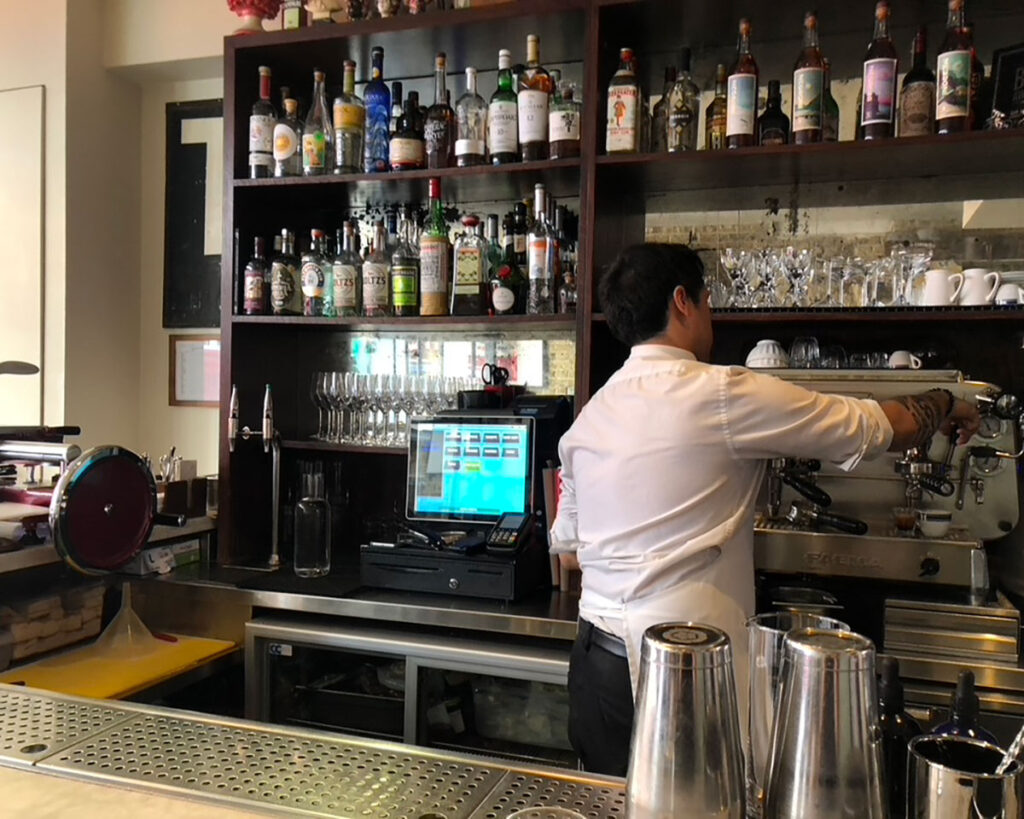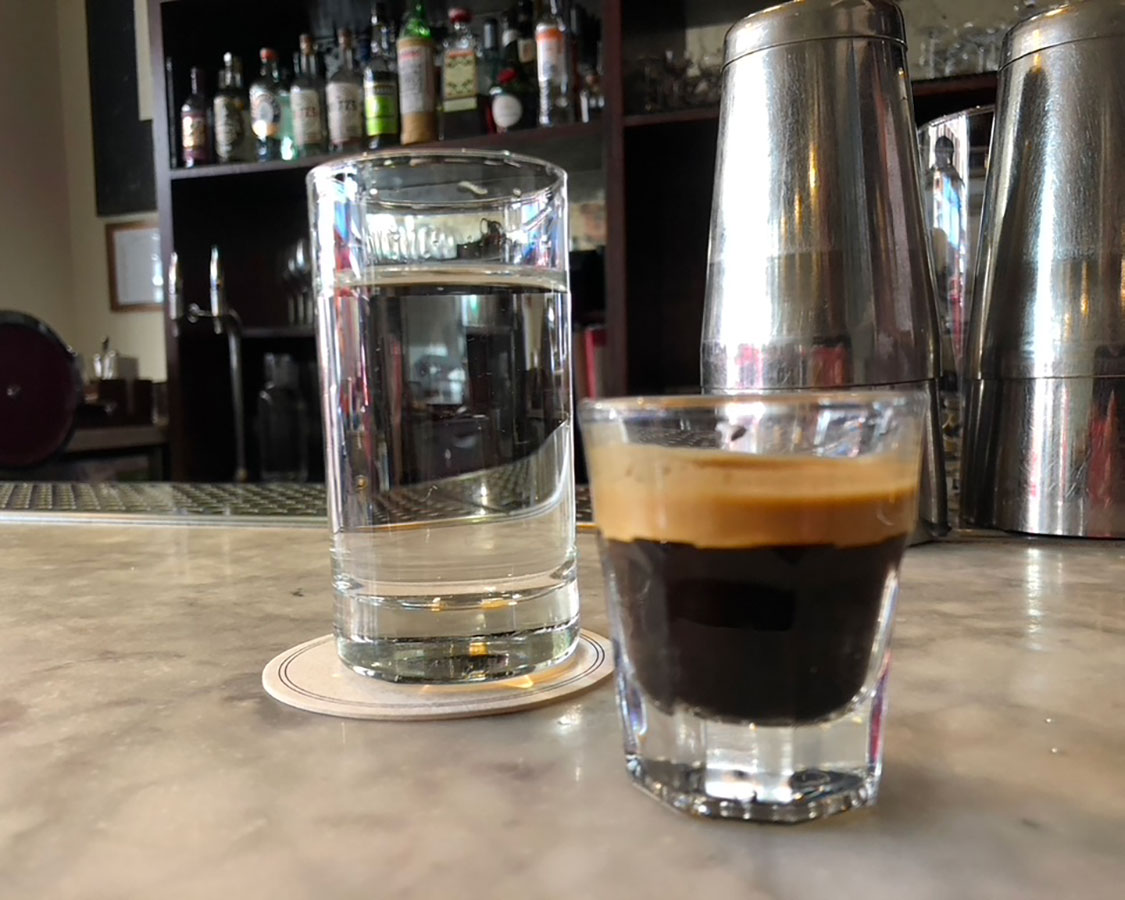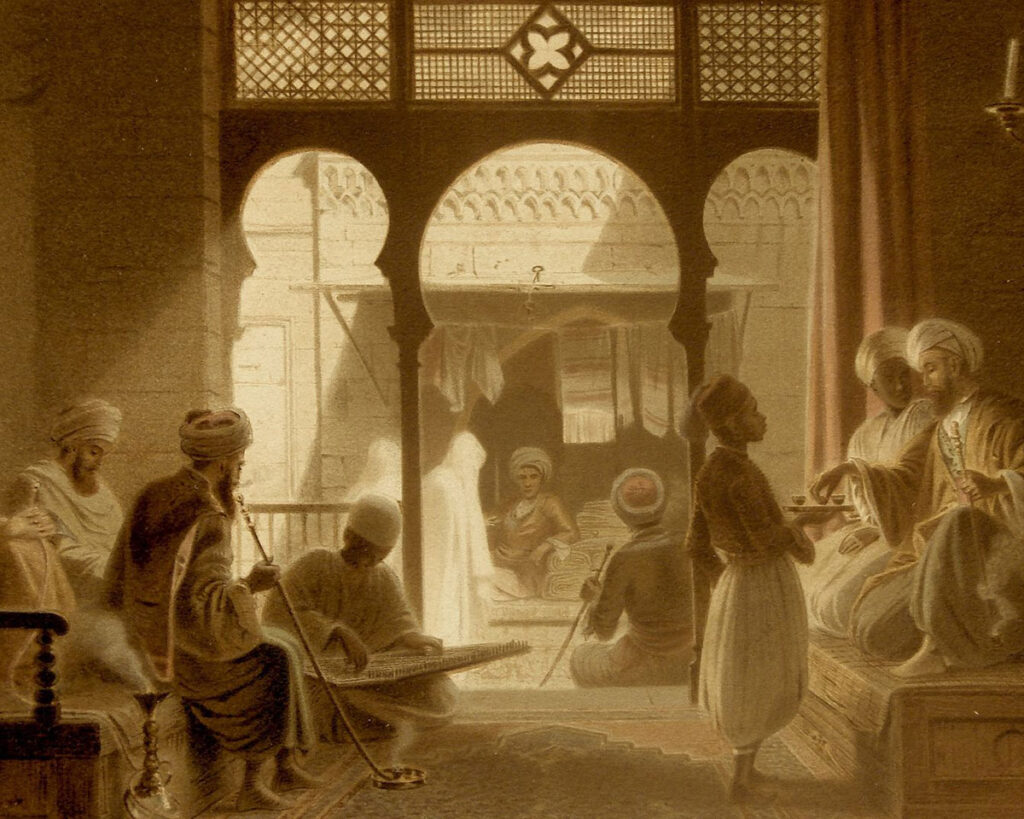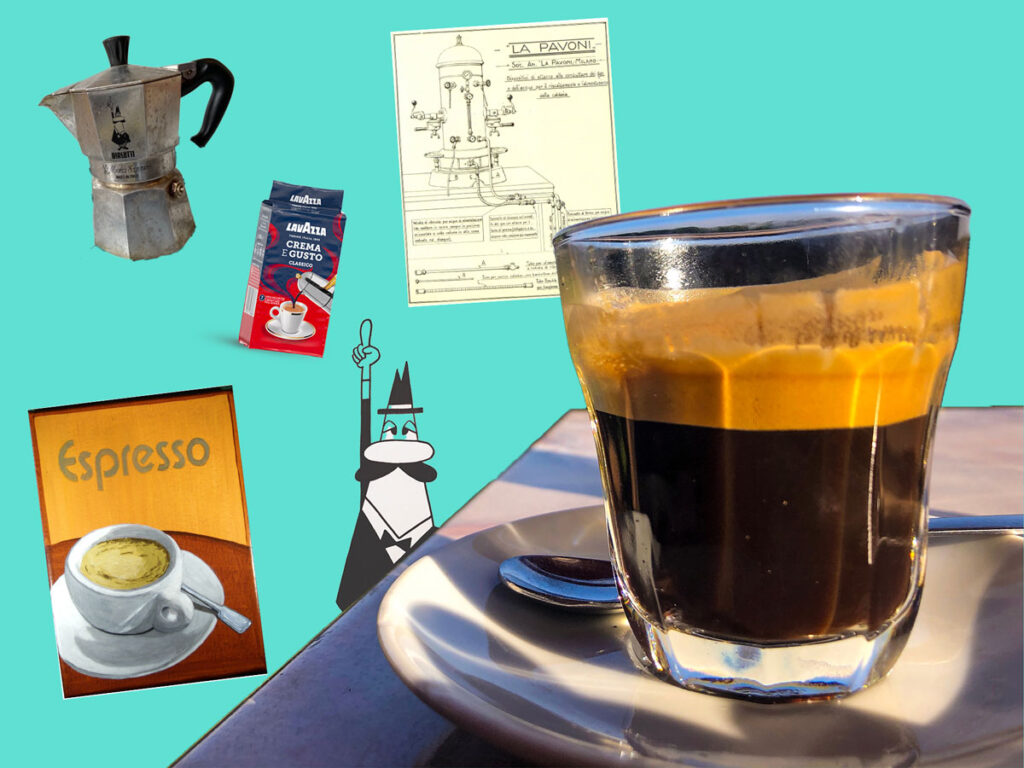I enter Bar Termini in London’s Soho on a sunny Saturday afternoon, on the hunt for a good Italian espresso to break up my day. Bar Termini is a small place, with only seven tables surrounding a curved marble counter in the corner. It sits meters away from a huge Caffe Nero, but the atmosphere is very different. There are no disposable cups or frappuccinos in sight: only tiny espressos served at the bar and the welcoming voice of Leonardo, the barista.
“Just a coffee, please,” I say in Italian. Before I can even ask, Leonardo has put a glass of water in front of me and is now setting up the espresso machine. “That’s how you spot a good barista,” my grandma once told me. “If they offer you a glass of water before your coffee, they know what they’re doing.” This is not just a cultural obsession. Cleansing your palate with water before drinking coffee is thought to prepare your tastebuds for a more intense sensory experience.
That Italians are precious about their food is not news. When it comes to coffee, our cultish obsession reaches new levels. I grew up in a small town near Milan, where I learnt how to prepare a moka before I learnt how to tie my shoes. It was my grandma who introduced me to the magic triad of coffee rules: never press the coffee, never wash your moka with soap and wait until it gurgles before removing it from the stove.
Every Thursday, my grandma would take my brother and I play in the main square. She would sit at the local caffetteria while sipping a caffè lungo, a longer version of espresso. On the way home, there was always something to complain about: the temperature of the milk; the barista’s grumpiness; the lady who dared to add sugar to her espresso. When I started travelling and we spoke on the phone, one of the first questions she would ask would be about coffee. I have always found it funny how a woman born and bred in Milan, who never left the country in her whole life, would say things like, “Coffee past the Alps is just dirty water.”


Coffee is Italian only by name. The beans grow in tropical climates and the plant itself is originally from Ethiopia. Yet ‘Italian coffee’ has become something of a trademark. Italian words dominate coffee shop menus around the world. The signature blend for Britain’s much-loved coffee chain, Costa, is called Italian Mocha. The London-born Caffè Nero promises its customers “a traditional Italian experience”. Starbucks was inspired by the coffee scene in Milan and Nespresso was born out of a Swiss engineer’s attempt to replicate “authentic Italian espresso”. But what is ‘authentic’ about Italian coffee?
“When we speak about Italian coffee, we are speaking about two different elements,” says Gabriele Cortopassi, managing director at the Espresso Academy in Florence. “Firstly, there’s the development of a new technology, the espresso machine. Secondly, there’s what we associate with coffee. Espresso is a recipe, but it’s also a way of life.”
Coffee was brewed in the Middle East and North Africa as far back as the 15th century. According to coffee historian Jonathan Morris, coffee was drunk in the South of the Arabic peninsula by the Sufi, who would use it to stay awake during their all-night vigils. By the end of the century, coffee houses had emerged across the Middle East as social hubs for the local aristocracy. During one of his trips to Egypt, Venetian botanist Prospero Alpini documented the use of this “decoction made from beans” for an Italian scientific journal. At the time, Western medicine was underdeveloped in comparison to that of the Ottoman Empire. Venetian merchants were soon to import the “black gold” for its medicinal properties and coffee infusions were used as digestion aids, stimulants and natural laxatives. After gaining the approval of Pope Clement VIII, who had initially condemned it for being “a Muslim beverage”, coffee began spreading to the rest of Italy and Europe – first as medicine, later as beverage. Around the 1650s, the first coffee houses were established in London.

According to Cortopassi, it was not until the 20th century that Italian coffee as we know it today was born. It was thanks to two engineering patents. The first one, in 1905, was La Pavone Ideale, a coffee machine able to pump pressurised water through a fine layer of ground coffee to produce a concentrated hot drink. The second one, in 1948, was the lever machine designed by Achille Gaggia, a barista from Milan. This machine could produce, in just 30 seconds, what was locally known as caffè crema (cream coffee), named after the thin layer of light brown foam that characterised the beverage. While coffee in the Middle East was mostly prepared as an infusion, these two machines introduced a new way of making coffee: “expressly”. As Morris writes in the book The Craft and Science of Coffee: “The espresso process economised on cost while delivering character. It required a small dose of coffee per cup and its intensification of flavours meant that cheaper beans could be used.”
“In Italy, the price of coffee has always been a political matter,” says Cortopassi. Judging from the heated arguments I have witnessed throughout my life, he’s not wrong. A coffee that costs more than €1? My father would call it “theft”. The cost of coffee is also why Italian people usually drink their coffee while standing. To control inflation, authorities could put a cap on essential items such as bread, coffee and tobacco. Coffee bars would then apply a surcharge for service at the table to make a profit during hard times. Historically, Italians have been used to standing while drinking espresso to avoid that surcharge.
“Espresso is not a drink for sitting and sharing, it’s just a pill of caffeine,” says Cortopassi. “The idea that espresso is something fast and modern remained. Italians are very keen about the quality of food in general, and we’re ready to understand that a product costs more because it’s better. If I go to a supermarket and buy Tavernello [a bag-in-box wine] that costs €1, or if I buy a Brunello di Montalcino [Tuscan red wine] that costs €40, I know the difference. I am paying for the quality. But if someone asks me more than €1 for a coffee, then I am going to think that the barista is stealing my money. For Italians, coffee is almost a need.” You can’t charge too much for a need or you’ll get a revolution.
Research shows that despite Italians being so proud of their coffee, most of them do not know what brand they drink when they visit their local coffee place. According to Cortopassi, what makes Italian coffee Italian is preparation and ritual: a moka on the stove when at home; a quick espresso at the counter when out. Just like tea in the UK, coffee is an Italian cultural institution and a form of national identity. When I asked Leonardo for “just a coffee” he knew exactly what I wanted. To many Italians, coffee is that dark, bitter, full-bodied double espresso to be downed while standing. The typical Italian bar is a come-and-go kind of place. You don’t “go out for a coffee”; you get a coffee while out. As I have learned, a coffee date is not a date.
Morris suggests that it is in these places, and through these rituals, that communities develop a collective sense of taste. This is certainly true for Italians who believe that coffee and pasta taste different when abroad, despite the same ingredients and recipes being used. But it is also true for tourists who might have tasted the food before but say that it tastes better when in the country. There is a sense of romance in the way we associate food with experiences, and experiences with a place.
The authenticity of “Italian coffee” as an idea was born among second-wave Italian immigrants in the UK, America and Australia. “After the Second World War, Italy was destroyed and we started having a lot of emigration again, especially to the Americas,” says Cortopassi. “People would bring their coffee machines with them and their knowledge about Italian espresso.” In London, the first Gaggia machine was installed in a coffee house in Soho in 1952. The British coffee house was a meeting place for British youth who did not want to meet their parents at the pub. The connection between Italy and coffee was soon made, given the presence of a lot of Italian immigrants in the hospitality industry and the fact that first espresso machines were manufactured in Italy. In America, this connection was even stronger, dating back to the first wave of Italian immigration, around the beginning of the 19th century. The first coffee houses played on the exoticism of this beverage and the “authenticity” of Italians’ obsession for food and drink – whether they were run by Italians or not.
Italian novelist Italo Calvino famously wrote in 1959: “In recent years, espresso-places have become fashionable in New York. Sure, I am happy when I can drink a coffee the Italian way, but I can’t explain to Americans the feeling of uneasiness that this kind of places provoke in me. The “Italian atmosphere” is created with marble tiny tables, busts of Roman emperors, fake Renaissance paintings, a speaker playing Italian opera…” Calvino’s sentiments are common among many immigrants and expats who witness the commercialisation of their food cultures. A study from the Specialty Coffee Association revealed that “the inclusion of espresso drinks and the attractive appearance of an espresso machine gives the operation an ‘upscale’ quality image”. But what is quality? “Quality is what you’re used to,” says Cortopassi.
British coffee culture today is still very different from my Italian experience and some places like Bar Termini remain touristy exotic places. “The authenticity in British coffee shops is supplied through the use of Italian-styled, espresso-based beverages,” writes Morris. In Italy, espresso is black, bitter and unsweetened while in the UK, espresso-based drinks are often enjoyed with added sugar or milk. Marco Arrigo, the founder of Bar Termini and director of the University of Coffee said in an interview with LeCool: “A 16oz latte is a pint of milk! With a dash of coffee. It’s a ridiculous drink, it’s been killing me for years. We used to put a dash of milk in our coffee, now we put a dash of coffee in our milk. It’s all gone a bit wrong.”
Coffee has been in my life for as long as I can remember. But while it used to be bags of Lavazza on the shelves of my family home, now it’s Nespresso capsules in the cupboard of a house-share kitchen. Queues at the coffee vending machine in high school are now Americanos in plastic cups outside the library. A six-cup moka pot on the stove after family dinners is now a quick espresso from a Sainsbury’s vending machine before a night out. If my grandma was still here she would probably blame it on the Americans, the people who brought coffee back to Italy after Mussolini banned it. But this is what happens to traditions: they change.
At Bar Termini, Leonardo refills my empty espresso cup with grappa Nonino and charge me the £1 “espresso at the bar” fee. I feel an inexplicable sense of nostalgia. You can be anywhere in the world, but rituals will always evoke memories and transport you somewhere. That is what Italian coffee is to me.
Read More

